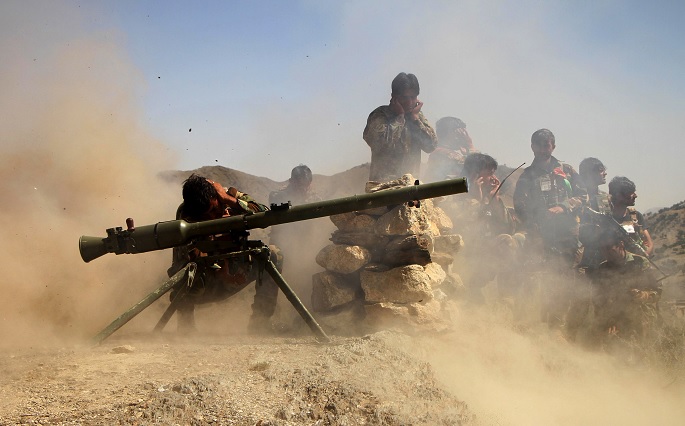

With the return of Taliban, a resurgence of deliberate sectarian-motivated attacks against the religious minorities has been witnessed in Afghanistan
<p>
<strong>In December 2001, the participants at the UN talks on Afghanistan during the historic Bonn Conference, which led to the formation of Interim Authority under the chairmanship of President Hamid Karzai, had agreed that there should be equitable representation of all ethnic and religious communities in the administration and the &#39;Emergency Loya Jirga&#39; – a special mass assembly – convened to bring peace, order and good government in Kabul.</strong></p>
<p>
Nearly two decades later, the landlocked country situated at the hub of South Asia and Central Asia, finds itself at the same crossroads once again with the conflict between the Taliban and various other political and ethnic groups, including those led by former Mujahedin leaders, threatening to spiral out of control. &nbsp;<br />
<br />
An estimated 80% of the Afghan population is believed to be Sunni while the remainder of the population – primarily the Hazara ethnic group – is predominantly Shia. While the percentage of Afghan ethnic groups has always been debated in absence of detailed and verified statistics, the US lists Pashtuns as the largest ethnic group in Afghanistan at 38-44% of the population, followed by Tajiks (25%), Hazaras (10%), Uzbek (6-8%), Aimaks, Turkmen, Baluchis, Nuristani, Pashaye, Arab and other small groups.</p>
<p>
<strong>The Tajiks<br />
</strong><br />
Majority of fighters in the Islamic fundamentalist group Taliban are from rural southern Pashtun backgrounds, especially Ghilzai Pashtuns.<br />
<br />
The resistance movement, meanwhile, has been mainly confined to the Tajik corner in the northeast and the Panjshir valley. Ahmad Massoud, the leader of the National Resistance Front, is son of Ahmad Shah Massoud – the much revered Tajik commander who is known as the &#39;Lion of Panjshir&#39; for his heroics against the Soviets and the Taliban.</p>
<p>
<img alt="Massoud" src="https://www.indianarrative.com/upload/news/Ahmad_Massoud.jpg" style="width: 100%; height: 100%;" /></p>
<p>
<em><strong>Ahmad Massoud (right) is the son of Ahmad Shah Massoud – famously called as the &#39;Lion of Panjshir&#39; for his heroics against the Soviets and the Taliban</strong></em></p>
<p>
Concentrated in northern Afghanistan, the number of Tajiks in Afghanistan increased manifold after the deadly civil war in Tajikistan. Refugee camps in the provinces of Balkh, Kunduz and Takhar were overflowing with internally displaced persons in the mid 1990s.<br />
<br />
Tajik leaders, including Burhanuddin Rabbani who served as Afghanistan president twice between 1992 to 2001, led the non-Pashtun Northern Alliance. Abdullah Abdullah, who is currently holding talks with the Taliban in Kabul, is also a Tajik-Pashtun and was once a top aide to senior Massoud.<br />
<br />
General Bismillah Mohammadi, the defence minister in Ashraf Ghani government who has vowed to &quot;liberate the nation from terrorists&quot; after the Taliban takeover, is also a Tajik.<br />
<br />
<strong>The Hazaras<br />
</strong><br />
They were once the largest Afghan ethnic group but now the Hazara minority, which has been targeted and killed by the Taliban and Islamic State-Khorasan Province (IS-PK) for practicing Shiite faith of Islam, is believed to be just about 10-15% of the Afghan population. &nbsp;<br />
<br />
With the return of Taliban, a resurgence of deliberate sectarian-motivated attacks against the religious minority has been witnessed as various agencies have accused the Taliban fighters for massacring nine men from the ethnic Hazara minority group after taking control of Ghazni province last month.<br />
<br />
A report of the European Asylum Support Office (EASO) stated that it is estimated that one quarter of the Kabul residents are Hazara while the rest of the population is spread all over the central regions of the country, including Hazarajat, Mazar-e-Sharif, Herat and others cities.<br />
<br />
Ustad Mohammad Mohaqiq, a prominent Mujahedin commander during the Soviet occupation, is one of the more&nbsp;prominent Hazara faces.</p>
<p>
<img alt="Afghanistan" src="https://www.indianarrative.com/upload/news/dostum.jpg" style="width: 100%; height: 100%;" /></p>
<p>
<em><strong>Atta Mohammad Noor (centre) with Abdul Rashid Dostum and Haji Mohammad Mohaqiq</strong></em></p>
<p>
<em><strong><br />
</strong></em><strong>The Uzbeks</strong></p>
<p>
A warlord and former Afghanistan Vice President, General Abdul Rashid Dostum is the leader of the &nbsp;Turkic-speaking ethnic Uzbeks in the country who form about 10% of the population. Majorly farmers by occupation who are concentrated in the north of the country, the Uzbeks flourished during the Soviet occupation. Having fought the Taliban in the late 1990s, the fate of the Uzbek community now hangs in balance as Dostum has fled the country after the Taliban took control of Kabul. &nbsp;<br />
<br />
<strong>Other ethnic Groups<br />
</strong><br />
Afghanistan&#39;s constitution officially recognizes 14 ethnic groups: Pashtun, Tajik, Hazara, Uzbek, Baluch, Turkmen, Nuristani, Pamiri, Arab, Gujar, Brahui, Qizilbash, Aimaq, and Pashai. The Shia Imami Ismaili Muslims, generally known as the Ismailis, are based in the north-eastern provinces. There are also a large number of Sikhs, Christians, members of the Bahai community and several Hindu families in the country. The Baluchis of Afghanistan live in the south-west and south in Helmand and Faryab provinces.</p>
<p>
<strong>Also Read: <a href="https://www.indianarrative.com/world-news/ahmad-massoud-amrullah-saleh-and-bismillah-mohammadi-lead-panjshir-resistance-agaisnt-taliban-108869.html">Ahmad Massoud, Amrullah Saleh and Bismillah Mohammadi lead Panjshir resistance against Taliban</a></strong></p>
<p>
<a href="https://www.indianarrative.com/world-news/ahmad-massoud-amrullah-saleh-and-bismillah-mohammadi-lead-panjshir-resistance-agaisnt-taliban-108869.html"><br />
</a></p>
Union Minister of Coal and Mines G Kishan Reddy on Tuesday held an inter-ministerial meeting…
India's largest automobile in-plant railway siding at Maruti Suzuki's Manesar facility started operation on Tuesday,…
Google on Tuesday unveiled its Safety Charter for India's AI-led transformation, at the "Safer with…
The human rights organisation of the Baloch National Movement (BNM), Paank, has published its most…
The Israel Defence Forces (IDF) on Tuesday claimed that it has killed Iran's senior-most military…
Amid escalating conflict between Iran and Israel, the Ministry of External Affairs (MEA) on Tuesday…